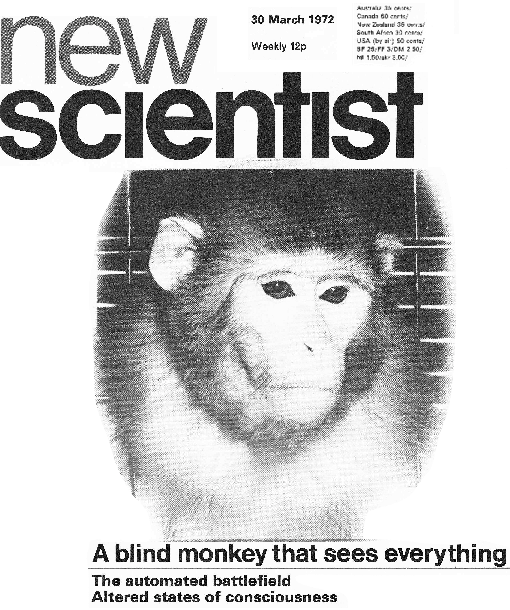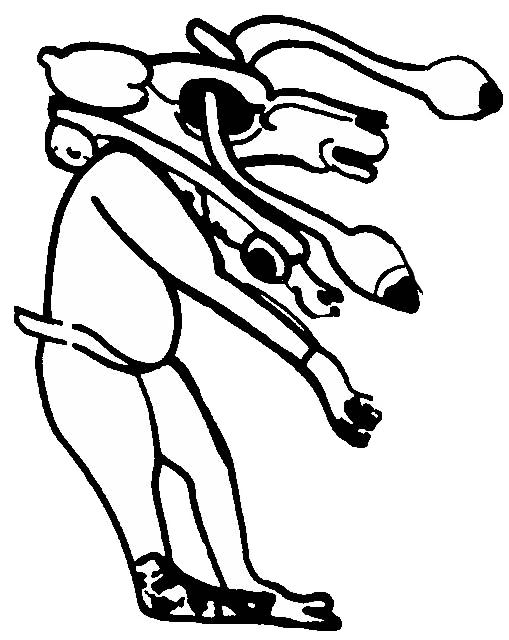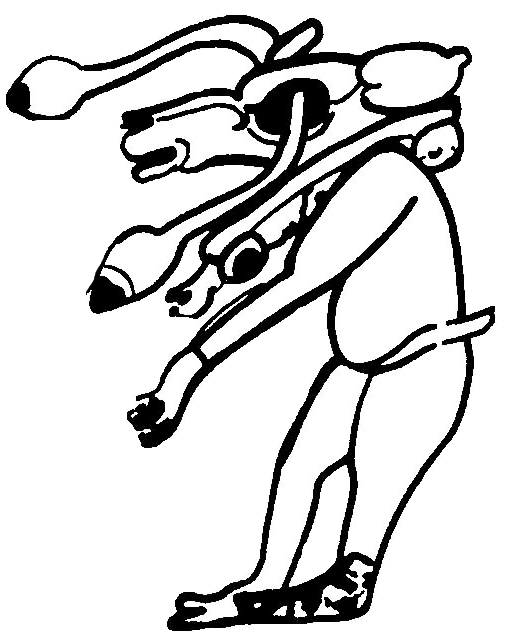ニコラス・ハンフリーによる知性の定義
On Social function of animal intellect

ニコラス・ハンフリーによる知性の定義
On Social function of animal intellect

ニコラス・ハンフリー(1976
[2004])は、動物の知性(intellect)を、動物の推論能力の適確さにもとめている。
「動物が根拠が確実で ある(valid)推論をおこない,それに基づいて行 動を変えるときに, 知性というものが発揮される。「根拠が確実な」 とは、論理的に適確であるということを意味してい るだけであり、その後に動物に利益がどのようにもたらされているのかという問題は問われない」(ニコラス・ハンフリー 2004:14)。
"An animal displays intelligence when he modifies his behaviour on the basis of valid inference from evidence. The word 'valid' is meant to imply only that the inference is logically sound; it leaves open the question of how the animal benefits in consequence." (Humphrey 1976:304)
ハンフリーによると、そのような知性の適 確さは、動物が、自然環境や、他の個体などのような社会環境のなかでのみ発揮できるという。「社会の複雑さと個体の知性の間に正の相関があると言えること が必要である」(ハンフリー 2004:28):My central thesis clearly demands that there should be a positive correlation across species between 'social complexity' and 'individual intelligence' . (Humphrey 1976:316).
動物(種)の知性とはそれぞれの個体が与 えられた環境の複雑さ——その最たるものは社会的環境である——と関係ある。つまり、複雑な社会生活を行う生物種には、知性があるように思われる——根拠 の確実性を感じる——というわけである。
主としての個人(個体)にとって知性の後 退とは、そのような複雑性に対して対処することができないことなのではないかと、私は思う。個体がそのような状態になったときに、人はその人をして「知性 がなくなった」あるいは「知性が後退した」と考えるわけである。
では認知症とは、知性が後退した状態なの
であるか? 私はそれだけではないと考える。
(a)知性の障害としての認知症と、 (b)コミュニ ケーション障害としての認知症があり、「知性」と「コミュニケーション」という2つの能力をブリッジする(c)もうひとつの認知=知性能力があるのではな いか。それらの間の関連性については、私は次のように考える。:
「ハンフリー、ニコラス「知の社会的機 能」『マキャベリ的知性と心の理論の進化論』リチャード・バーンとアンドリュー・ホワイトゥン編、藤田和生ほか監訳、Pp.12-28、ナカニシヤ出版、 2004年によると、知性の定義を、「他人(他の個体)が何を考えているのかを推論できる」ということですから、このあたりの認知障害と、コミュニケー ション障害がどのように形成されるのかと、語りを聞いて、他者のことを思いやる情動や知性がどのように関連しているのかについて考えればいのではないかと 思います」。
「動物行動学者のニコラ
ス・ハンフリー
は、高等霊長類における知性の誕生を、他者の推論プロセス(=能力)をその外部から推論する(=他の
個体が〈何を考えているのか〉を想像する)ことができることとして理解した。このことを我々の関心に引きつけて考えると、コミュニケーションのデコードに
はエンコードを推論することを必然的に引き出す。なぜなら我々は知性をもった存在間のコミュニケーションを扱っているからだ。エンコードの過程を推論する
能力がなければデコードする可能性は開かれない。従ってヒューマンコミュニケーションとは、エンコードとデコードに関わる推論プロセスであると言い換える
ことができる」(→「ディスコミュニケーションの理論に関する覚書」)
| Nicholas Keynes
Humphrey (born 27 March 1943) is an English neuropsychologist based in
Cambridge, known for his work on evolution of primate intelligence and
consciousness. He studied mountain gorillas with Dian Fossey in Rwanda;
he was the first to demonstrate the existence of "blindsight"[citation
needed] after brain damage in monkeys; he proposed the theory of the
"social function of intellect"[citation needed]. He is the only
scientist to have edited the literary journal Granta. Humphrey played a significant role in the anti-nuclear movement in the late 1970s and delivered the BBC Bronowski memorial lecture titled "Four Minutes to Midnight" in 1981. His 10 books include Consciousness Regained, The Inner Eye, A History of the Mind, Leaps of Faith, The Mind Made Flesh, Seeing Red, and Soul Dust. He has received several honours, including the Martin Luther King Memorial Prize, the Pufendorf Medal and the British Psychological Society's book award. He has been lecturer in psychology at Oxford, assistant director of the Subdepartment of Animal Behaviour at Cambridge, senior research fellow at Cambridge, professor of psychology at the New School for Social Research, New York, and school professor at the London School of |
ニコラス・ケインズ・ハンフリー(1943年3月27日生まれ)は、ケ
ンブリッジを拠点とするイギリスの神経心理学者で、霊長類の知能と意識の進化に関する研究で知られる。ルワンダでディアン・フォッシーとともにマウンテン
ゴリラを研究し、サルの脳損傷後の「盲目」[要出典]の存在を初めて証明し、「知性の社会的機能」[要出典]という説を提唱した。また、科学者で唯一、文
芸誌『グランタ』の編集を担当した。 1970年代後半の反核運動で重要な役割を果たし、1981年には「真夜中までの4分間」と題するBBCブローノフスキー記念講演を行った。 著書に『意識は取り戻された』『内なる目』『心の歴史』『信仰の跳躍』『肉体をつくった心』『シーイング・レッド』『ソウル・ダスト』など10冊。マー ティン・ルーサー・キング記念賞、プフェンドルフ・メダル、英国心理学会の書籍賞など、数々の栄誉に浴している。 オックスフォード大学心理学講師、ケンブリッジ大学動物行動学教室副所長、ケンブリッジ大学上級研究員、ニューヨークのニュースクール社会研究所の心理学 教授、ロンドン大学スクール・オブ・アメリカ教授を歴任。 |
| Family Humphrey is the son of the immunologist John H. Humphrey and his wife Janet Humphrey (née Hill), daughter of the Nobel Prize–winning physiologist Archibald Hill and the social reformer Margaret Hill. His great uncle was the economist John Maynard Keynes. Humphrey married Caroline Waddington, daughter of C. H. Waddington, in 1967 (divorced 1977). From 1977 to 1984 he was the partner of the English actress Susannah York. in 1994 he married Ayla Kohn, with whom he has two children, Ada (born 1995) and Samuel (born 1997). |
家族 ハンフリーは、免疫学者ジョン・H・ハンフリーと、ノーベル賞受賞の生理学者アーチボルト・ヒル、社会改革者マーガレット・ヒルの娘ジャネット・ハンフ リー(旧姓ヒル)の息子である。大伯父は経済学者のジョン・メイナード・ケインズ。1967年にC・H・ワディントンの娘であるキャロライン・ワディント ンと結婚(1977年に離婚)。1994年にアイラ・コーンと結婚し、エイダ(1995年生まれ)とサミュエル(1997年生まれ)の2人の子供がいる。 |
| Early career Nicholas Humphrey was educated at Westminster School (1956–61) and Trinity College, Cambridge (1961–67). His doctoral research at Cambridge, supervised by Lawrence Weiskrantz, was on the neuropsychology of vision in primates. He made the first single cell recordings from the superior colliculus of monkeys, and discovered the existence of a previously unsuspected capacity for vision after total lesions of the striate cortex (a capacity which, when it was later confirmed in human beings, came to be called "blindsight")[citation needed]. On moving to Oxford, he turned his attention to evolutionary aesthetics. He did research on monkey visual preferences[citation needed] (especially colour preferences) and wrote the essay "The Illusion of beauty", which, as a radio broadcast, won the Glaxo Science Writers Prize in 1980. |
初期のキャリア ニコラス・ハンフリーは、ウェストミンスター・スクール(1956-61年)、ケンブリッジのトリニティ・カレッジ(1961-67年)で教育を受けた。 ケンブリッジ大学では、ローレンス・ワイスクランツの指導のもと、霊長類の視覚の神経心理学に関する博士課程研究を行った。サルの上丘から初めて単一細胞 の記録を行い、線条皮質の完全な病変後にそれまで疑われていなかった視覚能力の存在を発見した(この能力は、後に人間で確認され、「盲視」と呼ばれるよう になった)[citation needed]。 オックスフォードに移ってからは、進化的美学に注目するようになった。サルの視覚嗜好(特に色彩嗜好)の研究を行い、「美の幻想」というエッセイを書き、 ラジオ放送として1980年にグラクソ科学作家賞を受賞している[citation needed]。 |
| Work in evolutionary psychology
and philosophy of mind He returned to Cambridge, to the Sub Department of Animal Behaviour in 1970, and there met Dian Fossey, who invited him to spend three months at her gorilla study camp in Rwanda. His experience with the gorillas, and a subsequent visit to Richard Leakey's field-site on Lake Turkana, set Humphrey thinking about how cognitive skills – intelligence and consciousness – could have arisen as an adaption to social life. In 1976 he wrote an essay titled "The Social Function of Intellect", which is widely regarded[citation needed] as one of the foundational works of evolutionary psychology and the basis for Machiavellian intelligence theory. This paper formed the basis of his first book, Consciousness Regained: Chapters in the Development of Mind (1983). In 1984 Humphrey left his academic post at Cambridge to work on his Channel 4 television series The Inner Eye, on the development of the human mind. This series was finished in 1986 with the release of a book of the same name. In 1987, Daniel Dennett invited Humphrey to work with him at his Center for Cognitive Studies at Tufts University. They worked on developing an empirically based theory of consciousness, and undertook a study on Multiple Personality Disorder. Humphrey's next book, A History of the Mind (1992), put forward a theory on how consciousness as feeling rather than thinking may have evolved. This book won the inaugural British Psychological Society's annual Book of the Year Award in 1993. His writings on consciousness continued in The Mind Made Flesh: Essays from the Frontiers of Evolution and Psychology (2002), Seeing Red: A Study in Consciousness (2006), and most recently Soul Dust: the Magic of Consciousness (2011). In this last book he puts forward a radical new theory. Consciousness, he argues, is nothing less than a magical-mystery show that we stage inside our own heads – a show that paves the way for spirituality, and allows us to reap the rewards, and anxieties, of living in what he calls the "soul niche". |
進化心理学と心の哲学に取り組む 1970年にケンブリッジ大学動物行動学部に戻り、そこでディアンフォッシーに出会い、ルワンダの彼女のゴリラ研究キャンプで3ヶ月間過ごすように誘われ ました。ゴリラとの体験や、その後リチャード・リーキーのトゥルカナ湖のフィールドサイトを訪れたことで、ハンフリーは、認知能力(知能や意識)が社会生 活への適応としてどのように発生したのかについて考えるようになったのです。1976年、彼は「知性の社会的機能」と題する小論を書き、この論文は進化心 理学の基礎となる著作の一つであり、マキャベリ的知性論の基礎となるものとして広く評価されている[citation needed]。この論文は、彼の最初の著書『意識は取り戻された』の基礎となった。Chapters in the Development of Mind (1983)の基礎となった。 1984年、ハンフリーはケンブリッジ大学での研究職を辞し、チャンネル4のテレビシリーズ「The Inner Eye」で、人間の心の発達について研究した。このシリーズは1986年に終了し、同名の本が出版された。 1987年、ダニエル・デネットは、タフツ大学の認知研究センターにハンフリーを招き、一緒に仕事をするようになった。彼らは、経験的な根拠に基づく意識 理論の開発に取り組み、多重人格障害についての研究を行った。 ハンフリーの次の著書『心の歴史』(1992年)は、考えることよりもむしろ感じることとしての意識がどのように進化してきたかについての理論を提唱して いる。この本は、1993年に英国心理学会の第1回ブック・オブ・ザ・イヤー賞を受賞している。 意識に関する彼の著作は、The Mind Made Flesh: Essays from the Frontiers of Evolution and Psychology (2002)、Seeing Red: A Study in Consciousness (2006)、そして最近ではSoul Dust: the Magic of Consciousness (2011)がある。この最後の本で、彼は根本的な新理論を提唱している。意識とは、私たちが自分の頭の中で演じる魔法のようなミステリーショーにほかな らない。このショーがスピリチュアリティへの道を開き、彼が「魂のニッチ」と呼ぶ場所で生きることの報酬と不安を私たちに与えてくれるのだ。 |
| Other work Humphrey became active in the anti-nuclear movement in the late 1970s. This led to an invitation to deliver the Bronowski lecture on the BBC in 1981. He titled his lecture, on the dangers of the arms race, "Four Minutes to Midnight". With Robert Lifton he edited an anthology of writings on war and peace, In a Dark Time, which was released in 1984 and was awarded the Martin Luther King Memorial Prize. In 1992, Humphrey was appointed to a Senior Research Fellowship at Darwin College, Cambridge funded by the Perrott-Warwick Fellowship in parapsychology. He undertook a sceptical study of parapsychological phenomena such as extra-sensory perception and psychokinesis, resulting in his book Soul Searching: Human Nature and Supernatural Belief (1995) (in America this book was published under the title Leaps of Faith). Humphrey has worked on a number of TV and radio documentaries as well as The Inner Eye. The topics range from the psychology of paranormal belief to the psycho-history of mediaeval animal trials. In 2005, he visited the Ulas family of human quadrupeds in southern Turkey and published a report on them with John Skoyles and Roger Keynes. A documentary entitled The Family That Walks on All Fours based on this visit was broadcast on BBC2 in March 2006, and on NOVA in November 2006. Over the last ten years Humphrey has been investigating the placebo effect, and has put forward a novel theory with John Skoyles of what he calls the "health management system" through which the brain has top-down control over the body's healing resources.[1] He has recently become an Advisor to the BMW Guggenheim Lab, and in 2016 he gave the annual Medawar Lecture at UCL.[2] Humphrey is an atheist and suggested the analogy of religion to viruses to Richard Dawkins.[3] National Life Stories conducted an oral history interview (C1672/12) with Nicholas Humphrey in 2016 for its Science and Religion collection held by the British Library.[4] |
その他の活動 1970年代後半、反核運動で活躍。1981年、BBCに招かれ、ブロノフスキー記念講演を行う。講演のタイトルは、軍拡競争の危険性を訴える「真夜中の 4分間」。ロバート・リフトンと共に編集した戦争と平和に関するアンソロジー『In a Dark Time』は1984年に出版され、マーティン・ルーサー・キング記念賞を受賞した。 1992年、ケンブリッジのダーウィン・カレッジで、ペロット・ウォーリック・フェローシップによる超心理学の上級研究員に任命された。超感覚的知覚やサ イコキネシスなどの超心理学的現象に対する懐疑的な研究を行い、その結果、Soul Searching: Human Nature and Supernatural Belief (1995) という本を出版しました(アメリカでは Leaps of Faith というタイトルで出版されています)。 ハンフリーは、「インナー・アイ」のほか、テレビやラジオのドキュメンタリー番組にも多数携わっています。超常現象を信じる心理学から、中世の動物裁判の 精神史まで、幅広いテーマを扱っている。 2005年には、トルコ南部の人間四脚のウラス族を訪れ、ジョン・スコイルズ、ロジャー・ケインズとともにそのレポートを発表した。この訪問を基にしたド キュメンタリー「四つん這いファミリー」が2006年3月にBBC2で、2006年11月にNOVAで放送された。 過去10年間、ハンフリーはプラシーボ効果について調査し、ジョン・スコイルズとともに、脳が身体の治癒力をトップダウンでコントロールする「健康管理シ ステム」と呼ぶ新しい理論を提唱している[1]。 彼は最近、BMWグッゲンハイム研究所の顧問になり、2016年にはUCLで年次メダワー講義を行った[2]。 ハンフリーは無神論者であり、リチャード・ドーキンスに宗教とウイルスの類似性を提案した[3]。 ナショナル・ライフ・ストーリーズは、大英図書館が所蔵する「科学と宗教」コレクションのために、2016年にニコラス・ハンフリーにオーラルヒストリー インタビュー(C1672/12)を実施した[4]。 |
| Bibliography Consciousness Regained: Chapters in the Development of Mind, Oxford University Press, 1983. In a Dark Time, (ed. with R. J. Lifton), Faber & Faber 1984, Harvard University Press, 1984. The Inner Eye: Social Intelligence in Evolution, Faber & Faber, 1986; Oxford University Press 2002, ISBN 9780192802446 [1] A History of the Mind, Chatto & Windus 1992, Simon & Schuster, 1992. Soul Searching: Human Nature and Supernatural Belief, Chatto & Windus, 1995. How to Solve the Mind-Body Problem, Imprint Academic, 2000. The Mind Made Flesh: Essays from the Frontiers of Evolution and Psychology, Oxford University Press, 2002. Seeing Red: A Study in Consciousness, Belknap Press/Harvard University Press, 2006. Soul Dust: The Magic of Consciousness, Quercus Publishing, 2011, Princeton University Press, 2011 |
参考文献 『意識の回復:心の発展の章』オックスフォード大学出版局、1983年。 『暗い時代』(R. J. リフトンと共編)、ファーバー&ファーバー、1984年、ハーバード大学出版局、1984年。 『内なる目:進化における社会的知性』ファーバー&ファーバー、1986年、オックスフォード大学出版局、2002年。ISBN 9780192802446 [1] 『心の歴史』、チャット&ウィンドゥス、1992年、サイモン&シュスター、1992年。 『魂の探求:人間の本性と超自然的な信念』、チャット&ウィンドゥス、1995年。 『心身問題解決の方法』、インプリント・アカデミック、2000年。 The Mind Made Flesh: Essays from the Frontiers of Evolution and Psychology、オックスフォード大学出版局、2002年。 Seeing Red: A Study in Consciousness、ベルナップ・プレス/ハーバード大学出版局、2006年。 Soul Dust: The Magic of Consciousness、クエルクス出版、2011年、プリンストン大学出版局、2011年 |
| Video links "Four Minutes to Midnight: the 1981 BBC Bronowski Lecture" on YouTube. "Natural Psychologists", Part 2 of The Inner Eye on YouTube. "The Ghost in the Machine", Part 3 of The Inner Eye on YouTube. "Sentimental Education", Part 4 of The Inner Eye on YouTube. "Other People's Dreams", Part 5 of The Inner Eye on YouTube. "Is There Anybody There?" on YouTube. "The Pufendorf Lectures 2011". |
ビデオリンク YouTube「真夜中まであと 4 分:1981 年の BBC ブロノフスキー・レクチャー」。 YouTube「The Inner Eye」第 2 部「Natural Psychologists」。 YouTube「The Inner Eye」第 3 部「The Ghost in the Machine」。 YouTube「The Inner Eye」第 4 部「Sentimental Education」。 YouTube「The Inner Eye」第 5 部「Other People's Dreams」。 「そこに誰かいるか?」YouTube。 「プフンドルフ・レクチャー 2011」。 |
| https://en.wikipedia.org/wiki/Nicholas_Humphrey |
●Humphrey, Nicholas., 1999. A history of
the mind : evolution and the birth of consciousness. Copernicus.
This book is a tour-de-force on how human consciousness may have evolved. From the "phantom pain" experienced by people who have lost their limbs to the uncanny faculty of "blindsight," Humphrey argues that raw sensations are central to all conscious states and that consciousness must have evolved, just like all other mental faculties, over time from our ancestors'bodily responses to pain and pleasure. "Humphrey is one of that growing band of scientists who beat literary folk at their own game"-RICHARD DAWKINS "A wonderful bookbrilliant, unsettling, and beautifully written. Humphrey cuts bravely through the currents of contemporary thinking, opening up new vistas on old problems offering a feast of provocative ideas." -DANIEL DENNETT
「この本は、人間の意識がどのように進化してきたかについて、見事な論証を展開している。手
足を失った人々が経験する「幻の痛み」から、不思議な能力である「盲視」まで、ハンフリーは、生の感覚がすべての意識状態の中心であり、意識は他のすべて
の精神機能と同様に、私たちの祖先の痛みや喜びに対する身体的反応から、長い時間をかけて進化してきたに違いないと主張している。「ハンフリーは、文学者
たちをその得意分野で打ち負かす科学者の数少ない一人だ」-リチャード・ドーキンス「素晴らしい本だ。
brillantで、不安を掻き立て、美しく書かれている。ハンフリーは、現代の思考の流れを勇敢に切り裂き、古い問題に新たな展望を開き、刺激的なアイ
デアの饗宴を提供している」-ダニエル・デネット
Mind and Body.- "Puzzling Work": An Aside About Language.- What Happened in History: The Inside Story.- The Double Province of the Senses.- "What Do We See?".- Color is the Keyboard.- In the Realm of the Senses.- Shuttle Vision.- "It Must Look Queer!".- New Arrangements.- Mind-Blindness and Blind-Mindness.- More About Blindsight.- A Fire In The Hand
心と体.- 「不思議な仕事」:言語に関する一考察.-
歴史で何が起こったのか:内幕.- 感覚の二重の領域.- 「私たちは何を見ているのか?」- 色はキーボードだ.- 感覚の世界.-
シャトルビジョン.- 「それは奇妙に見えるはずだ!」.- 新しい配置.- 心の盲目と盲目の心.- 盲視についてさらに.- 手の中の火
A Dagger of the Mind.- He Thought He Saw An Elephant.- Here It Lies.- Here What Lies? A Chapter About Definition.- Five Characteristics in Search of A Theory.- The Problem of Ownership (A Tack to Starboard).- The Question Of Indexicals (A Tack to Port).- Plus CA Change....- A Little Mind Music.- Specific Nerve Energies?.- Smoke Without Fire.- Time Present.- Hurrah!.- Being and Nothingness.- 229.- 235.
心の短剣。彼は象を見たと思った。ここにそれはある。ここに何がある?定義に関する章。理論
を求める五つの特徴。所有権の問題(右舷へ舵を切る)。- 指示詞の問題(左舷への舵取り)。- プラスCAの変化……。- 心の音楽。-
特定の神経エネルギー?.- 火のない煙。- 現在時。- やった!.- 存在と無。- 229。- 235。
リンク
文献
Do not paste, but [re]think this message for all undergraduate students!!!


++
Copyleft, CC, Mitzub'ixi Quq Chi'j, 1996-2099
☆
 ☆
☆